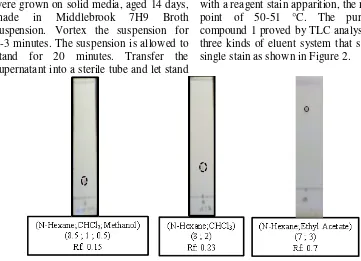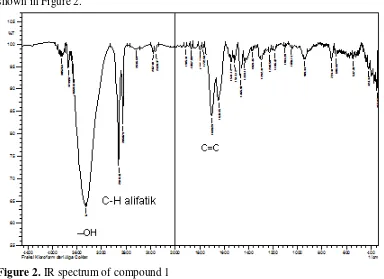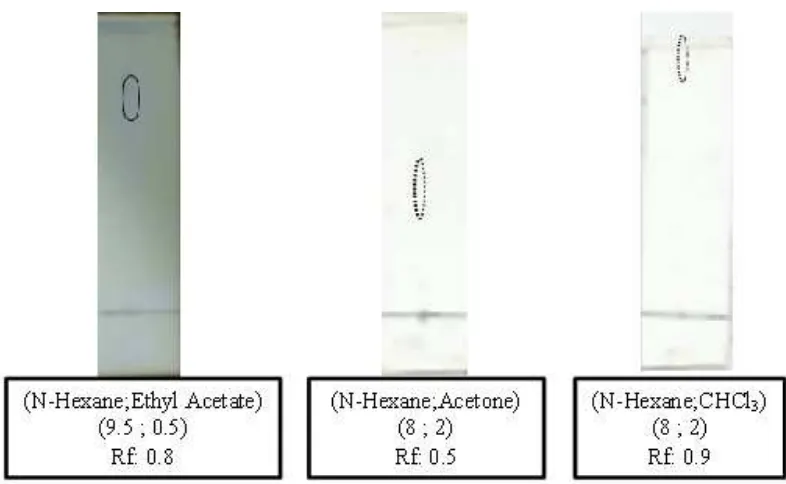1
ISOLATION AND IDENTIFICATION OF SECONDARY METABOLITES OF CHLOROFORM FRACTION OF MACROALGAE Padina australis
AS ANTI TUBERCULOSIS
Eka Pridawati1, Ahyar Ahmad, Usman Hanapi
Department of Chemistry, Natural Sciences Faculty of Hasanuddin University
Abstrak. Penelitian ini bertujuan mengisolasi senyawa metabolit sekunder makroalga Padina australis fraksi kloroform dan untuk mengetahui konsentrasi minimum dalam menghambat pertumbuhan Mycobacterium tuberculosis. Metode penelitian yang digunakan melalui tahapan-tahapan: ekstraksi, isolasi, pemurnian, elusidasi struktur, dan uji bioaktivitas. Dua senyawa diperoleh dari penelitian ini. Pertama: golongan steroid dan kedua: golongan terpenoid (senyawa 2) dengan nilai Minimum Inhibition Concentration (MIC) terhadap M. tuberculosis adalah 400 µ g/mL dan pada konsentrasi 100 µ g/mL, senyawa 2 juga mampu meningkatkan aktivitas rifampisin 0,5 µg/mL dalam menghambat pertumbuhan bakteri M. Tuberculosis.
Kata Kunci : Anti tuberculosis, identifikasi, isolasi, metabolit sekunder, Padina australis
Abstract. This study aims to isolate the secondary metabolites of macroalgae Padina australis and the chloroform fraction to determine the minimum concentration to inhibit the growth of Mycobacterium tuberculosis. The methods used through the stages: extraction, isolation, purification, structure elucidation, and bioactivity test. In this research, we obtained two compounds: (i) steroids and (ii) terpenoids (compound 2) with the value of the Minimum Inhibition Concentration (MIC) against M. tuberculosis was 400 µ g/mL and also at a concentration of 100 µg/mL. Compound 2 also increased the activity of rifampicin 0,5 µ g/mL in inhibiting the growth of bacteria M.Tuberculosis.
Keywords: Anti tuberculosis, identification, isolation, Padina australis, secondary metabolites
1
2 Approximately 10% cases of TB infection in the world is found in Indonesia and puts it in third place behind India and China. This was due to the presence of multidrug resistance M. tuberculosis causes the condition is getting worse, not only in Indonesian and even hit around the world, both developing and developed countries (WHO, 2009). Therefore, research for new anti-tuberculosis drugs, effective, and affordable is necessary to tackle TB disease, including therapeutic procedures or administration of anti-TB drugs (new treatment guidelines).
In the last two decades is estimated to have been isolated and identified in 2500 secondary metabolites from marine biota and symbionts, and as many as 353 of them suspected compound has potential as an ingredient the new of anti-tuberculosis (Mayer, et al., 2011). Extracts of secondary metabolites from marine algae contain bioactive compounds that are known to have pharmacological activity properties such as antibacterial (Muniarsih and Rachmaniar, 1999), and anti-tuberculosis (Copp and Pearce, 2007; Tasdemir, et a.l, 2007; Azevedo, et al., 2008; Abdel-Aal,. et al., 2010). So far is very less even no research data that explored group of nonpolar compounds from marine algae and bacterial symbionts as a raw material of anti-tuberculosis drugs.
Exploration and marine research for pharmaceutical use has grown rapidly within 30-40 years. It is accelerated by increasing consumer awareness and drug industry (pharmaceuticals) at home and
abroad to prioritize the use of drugs from natural products known as "back to nature" (Rismana, 2001).
The results research from Massi and Ahmad (2011), showed that the red algae Gelidium amansii of Baranglompo island waters shown to contain anti-tuberculosis protein compounds that could
inhibit directly or indirectly, the growth of M. tuberculosis strain H37Rv (ATCC
27394). Utilization of bioactive compounds will be even better if it can be obtained from the sources of raw materials abundant algae and algal species are relatively abundant in the waters of Indonesia.
P. australis is one type of brown algae that have economic value because it is useful as an animal feed, human food, fertilizer, and in the health field are useful as anti-bacterial and anti-microbial.
dried for isolation purposes.
Extraction and Identification of Secondary Metabolites
3 Isolation and Purification of Secondary Metabolites
Partition results using KKV were fractionated into several fractions in which the eluent used can be determined based on the results of the TLC analysis. Fractions obtained were monitored by TLC and fractions that have the same Rf values are merged into one major fraction, then evaporated to dryness, the specified weight. Fractionation process is done repeatedly until pure isolates obtained using the KKT or KKG with the appropriate eluent. Isolates was tested by TLC and tested its bioactivity.
Structure Elucidation of Compounds The molecular structure of pure isolate compounds that have anti-tuberculosis maximum bioactivity will be elucidated by ultraviolet spectroscopy (UV), Infrared (IR), nuclear magnetic
resonance (NMR) and Gas
Chromatography-Mass Spectroscophy (GC-MS) (Usman, 2005).
Inoculum M.tuberculosis H37Rv
Culture of M. tuberculosis H37Rv were grown on solid media, aged 14 days, made in Middlebrook 7H9 Broth suspension. Vortex the suspension for 2-3 minutes. The suspension is allowed to stand for 20 minutes. Transfer the supernatant into a sterile tube and let stand
for 15 minutes. Move again supernatant into another sterile tube. Next create a suspension of M. tuberculosis H37Rv in PBS at No. turbidity standard. 0.5 McFarland. Dilute 1 mL of a suspension of M. Tuberculosis H37Rv 0.5 McFarland in 4 mL of PBS in a sterile tube inserted.
Test Minimum Inhibitory
Concentration (MIC) against M.Tuberculosis
4 ml of MGIT medium was added compounds 2 and 3 with a final concentration variation in tube 0 µg/mL, 100 µg/mL, 200 µg/mL, dan 400 µg/mL and rifampicin with end concentration of the tube 0 μg/mL, 1 μg/mL, and 2 μg/mL. The tubes are then sealed, shaken, the outside of the tube is cleaned with disinfectant tuberkulosidal, and incubated at 37 °C. Observations were made every day from 3rd day until 14th day.
RESULTS AND DISCUSSION Compound 1
13.41 mg of compound 1 in the form white powder with TLC shows a single stain, not fluorescent, visible only with a reagent stain apparition, the melting point of 50-51 °C. The purity of compound 1 proved by TLC analysis with three kinds of eluent system that shows a single stain as shown in Figure 2.
4
Spetrokfotometer FTIR spectrum of the compound 1 gave the following as shown in Figure 2.
Figure 2. IR spectrum of compound 1
Table 1. Absorption peaks IR data of compounds 1 and β-sitosterol (Patra, et al., 2010) No. Absorption peaks
(cm-1)
β-sitosterol (cm-1) Types of functional groups
1 3450 3549, 99 -OH stretching vibration alkohol
2 2918 and 2850 2935, 73 and 2867, 38 aliphatic CH stretching vibration
3 1643 1637, 63 C = C stretching vibration
After the test is done by comparison of TLC pure crystals (β-sitosterol) by Usman (2006) simultaneously, with a single stain showed the same Rf value is 0,63.
5 Analysis of IR spectra obtained results in Table 3 do not show a considerable difference in wavelength shift. However, the results and data analysis IR spectroscopy and TLC single isolates with β-sitosterol is not enough to conclude that compound 1 is β-sitosterol considering the melting point of the compound 1 around 50-51 °C, while the melting point of β-sitosterol is 139-142 °C (ChemNet, 2001). Thus compound 1 can only be inferred based on the results of the test steroid group (Table 2).
Compound 2
43,10 mg of compound 2 as a white powder with a melting point 49-50 °C and does not fluorescence under UV light. The results of TLC analysis after being sprayed with stain and heated apparition showed elongated single stain (Figure 4). Class ification test for compound 2 is shown in Table 4 indicates that the compound belongs to a class of steroids.
Figure 4. Chromatogram results of TLC analysis of compound 2 Table 2. Testing class of compounds in each fraction
No. Extract & Crystals Test Group
Terpenoids Steroids Phenolic Flavanoid
1 Methanol extracts - + - -
2 CHCl3 extract - + - -
3 Compound 1 - + - -
4 Compound 2 + - - -
6 Figure 5. IR spectrum of compound 2
Table 6.The data of IR absorption peaks of compounds 2
No. Absorption peaks (cm-1) Types of functional groups
1 3452 -OH stretching vibration alkohol
2 2954, 2918 and 2848 aliphatic CH stretching vibration
3 1701 C = O stretching vibration
4 1465 bending - CH
From the results of GC-MS spectroscopic analysis of the compounds seen 5 peaks in the chromatogram. Visible peaks on the chromatogram that have different characteristics as shown in Table 6, by comparing the GC-MS spectrum of the data obtained with the standard compound mass spectrum of the GC-MS data base (Wiley 275, Lib) is appropriate, then the expected compound is oxybis-(CAS) Dimethyl ether. Based on spectroscopic data, the IR (KBr) cm-1 υ maks: at wave number 3452 cm-1 indicates a stretching vibration (-OH) of an alcoholic. The existence of absorption peaks at wave numbers 1701 cm-1 indicate the presence of carbonyl group (C = O) carboxylate. Absorption at 2954, 2918, and 2848 cm-1 shows the presence of
aliphatic CH stretching vibration and the absorption at 1465 cm-1 indicates the presence of CH bending (Figure 13), so it does not match the structure of the data contained GC-MS with data from FTIR. So, based on the results of the classification test and the data from FTIR can be inferred is a class of terpenoids with functional groups include OH and C = O.
Anti-tuberculosis Activity of Compounds 2
7 MGIT medium can be seen in Table 10. From these data it can be seen that in the negative control (P1) of observations to
test the MIC against bacteria M. tuberculosis Strains H37Rv. Negative
control no containing compounds 2 and rifampicin drug (inoculum, OADC, and the solvent alone) was much overgrown by bacteria M. tuberculosis H37Rv strains were characterized by high levels of M. tuberculosis Strain H37Rv. However, when the concentration of rifampicin 0,5 µ g/mL and compound 2 concentration of 100 µg/mL (P6) found no bacterial growth M. tuberculosis Strain H37Rv. This shows no effect of compound 2 in
inhibiting the growth of bacteria M. tuberculosis Strain H37Rv. At the
table also shows the growth of M. tuberculosis H37Rv strain can be
directly inhibited by compounds 2 without the addition of rifampicin at a concentrat ion of 400 µg/mL (P10).
Table 9. The effects of addition compound 2 in combination with rifampicin on the growth of M. tuberculosis H37Rv strain on medium MGIT
Rifampicin (µg/mL) P. australis contain components secondary
metabolites. Components of secondary metabolites between another class of steroids and terpenoids.
Compound 2 (terpenoids) is able to
8 2. Ahmad, A. and Massi, M.N., 2011,
Anticancer activity of native and recombinant protein lectins from marine algae against human HeLa cancer cells, Inclusive preparation. 3. Atmadja, W.S., 1990, Research and
Development Centre for Oceanology-LIPI, Seaweed as medicine Oseana, 17 (1): 1-8, Jakarta.
4. Azevedo, L.G., Muccillo Al-Bai s ch, Filgueira Dde I, Boyle R, 2008, Comparative Cytotoxic and Anti-Tuberculosis Activity of Marine Sponge Aplysina Caissara Crude Extracts, Comp Biochem Physiol C Pharmacol Toxicol, 147 (1): 36-42. 5. ChemNet., 2001, 83-46-5 beta-mycobacterial Activity of Lectin Proteins in Combination with Streptomycin to Increase Sensitivity Against Mycobacterium tuberculosis, in submittion.
7. Mayer, A.M.S., Rodriguez, A.D., Berlinck, R., and Fusetani, N., 2011, Marine pharmacology in 2007-8: Marine Compounds with Antibacterial, Anticoagulants, Antifungal, Anti-inflammatory, antiprotozoal, antituberculosis and Antiviral Activities; affecting the Immune and Nervous System, and other Miscellaneous Mechanisms of Action, Comparative Biochemistry and Physiology Part C, 153: 191-222.
8. Muniarsih, T. and Rachmaniar, R., 1999, Identification of Antimicrobial Compounds from Sponges Aaptos Aaptos of Islands Spermonde by Mass Spectroscopy, Oseon ologi LIPI Research Center, Jakarta.
9. Patra, A., Jha, S., Murthy, P.N., Manik, and Sharone, A., 2010, Isolation and characterization of stigmast-5-en-3β-ol (β-sitosterol) from the leaves of Hygrophila spinosa T. Anders, International Journal of Pharma Sciences and Research, 1 (2): 95-100. 10.Rismana, E. , 2001. Potentially Large
Marine Life so Source Raw Materials Drugs of the Pharmaceutical Industry, (Online),
(http://Biota20Berpotensi%%%20Laut 20Besar.html, accessed January 25, 2008). Reductases From inhibit the Plasmodium falciparum, Mycobacterium tuberculosis and, Escherichia coli,15: 6834-6845. 12.Usman, H. , 2005, 2',4'-dihydroxy-3', 5
', 6'-trimetoksicalkon An Anti-Tumor Compounds of Skin Stem plants Criptocarya costata (Lauraceae), ITB Journal of Mathematics and Science, 10: 97-100.
13.World Health Organization, 2009, Tuberculosis Fact Sheet. Available from http://www.who.int/mediacentre/ factsheets/fs104/en, Accessed on



